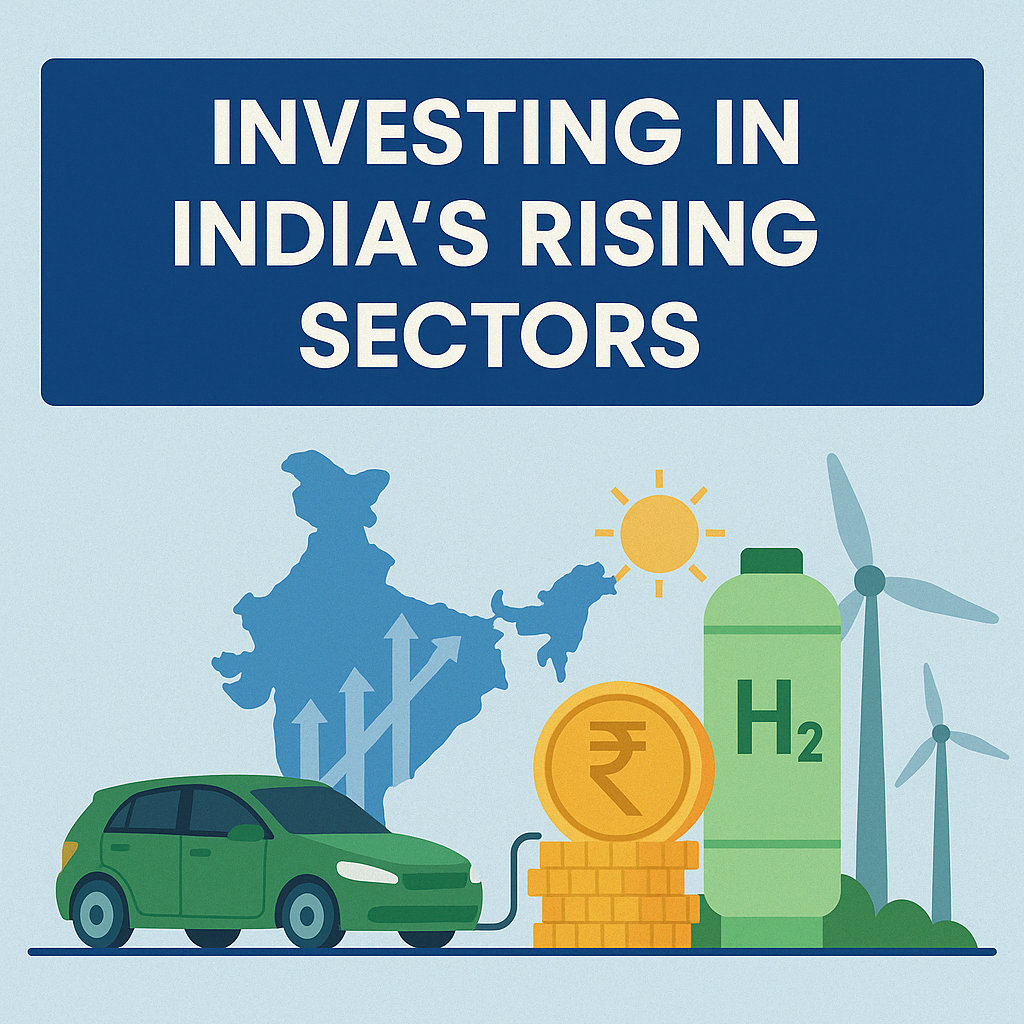Introduction
How to Invest in Electric Vehicles & Green Hydrogen in 2025? These fast-growing sectors are reshaping the future of clean energy and offer great opportunities for smart investors.
Investing in Electric Vehicles & Green Hydrogen: India is undergoing a radical change in the way that it produces and uses energy. Among the many ways that energy production will change, two stand out as the most prominent for the overall progress of the nation, and for individual investors; Electric Vehicles (EVs), and Green Hydrogen.
These are not only good for the planet but can also be great for investors who want to grow their money in the long run irrespective of their country.
In this blog, we’ll explain everything you need to know about investing in these quickly growing industries—from what they are, why they matter, and how you can safely and smartly invest in them for the future.
Whether you are an investor that is just starting out, or a seasoned investor, you will gain valuable information on how to invest in Electric Vehicles & Green Hydrogen during this presentation.
What Are Electric Vehicles and Green Hydrogen?
What is an Electric Vehicle?
Electric Powered Vehicles, or EVs, are those vehicles which operate on electricity, rather than natural fuels. They depend on rechargeable batteries to run. EVs like “cars, bikes, buses, and trucks” offer a cleaner and more friendly alternative to petrol or diesel vehicles.
Compared to fuel vehicles, EVs don’t produce smoke, which keeps the air cleaner. Additionally, they are lower in cost and easier to maintain, as they don’t require oil changes or other checks.
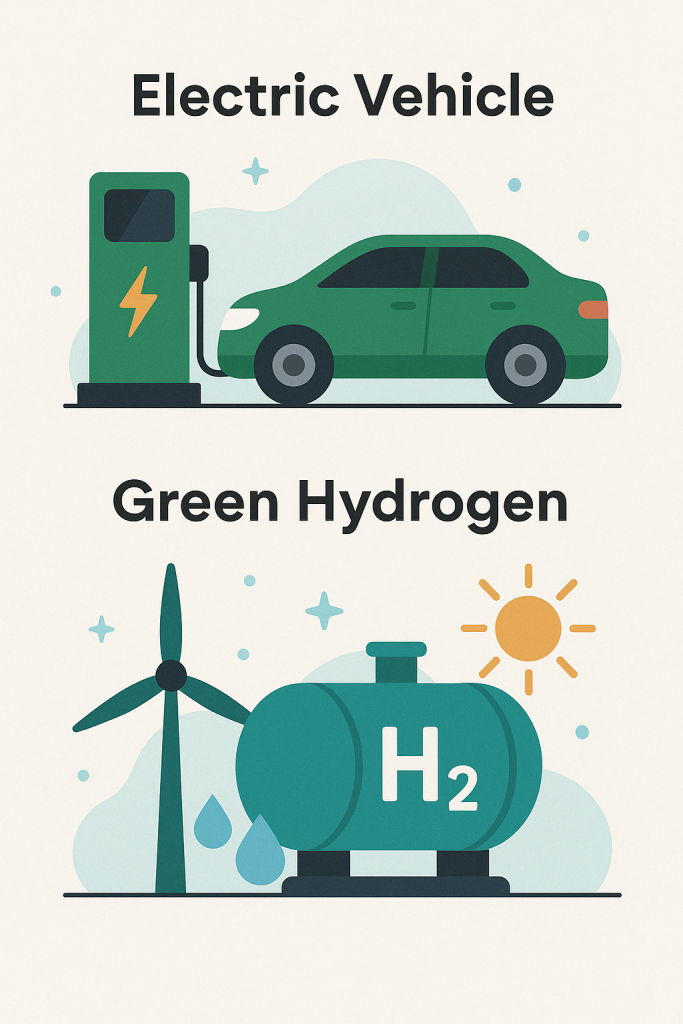
Understanding Green Hydrogen
Green hydrogen is a fuel made using electricity from renewable sources (e.g. sunlight, wind, etc.) to split water into hydrogen and oxygen, through a process called electrolysis. This hydrogen can be stored and later deployed to power machinery, manufacturing plants, and also vehicles.
It is called “green†hydrogen because the electricity that we use to create it is green or renewable. Therefore, the overall process is not harmful to the environment.
Why Do These Sectors Matter Right Now?
1. Government Policies and Incentives
The Indian government has made EV and hydrogen sectors a priority:
- FAME II Scheme: Subsidies and financial incentives for buyers of electric vehicles.
- PLI Scheme: Supports companies that make batteries and work on green hydrogen in India.
- National Hydrogen Mission: Launched to help India become one of the top global producers of green hydrogen by 2030.
According to NITI Aayog, India is actively developing policies to promote electric mobility and green hydrogen as part of its clean energy roadmap.
These policies have laid a solid foundation for the industry and clearly demonstrates the government’s commitment to invest in Electric Vehicles & Green Hydrogen.
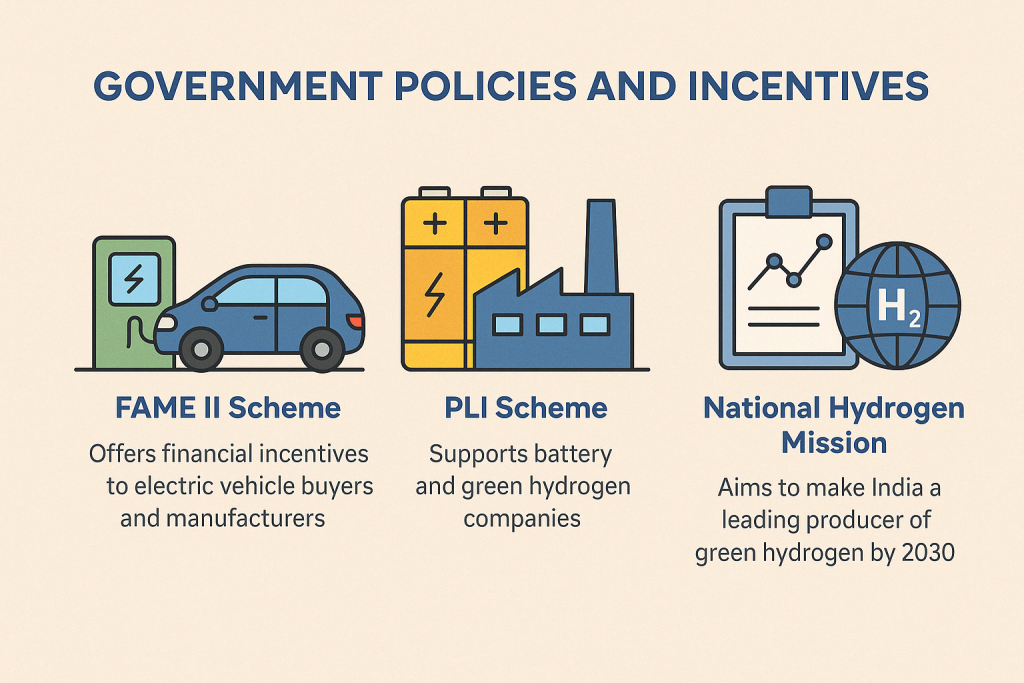
2. Environmental Necessity
The AQI in many metropolitan areas is getting worse because of smoke and burning fossil fuels. Transitioning to greener energy is no longer an economic opportunity, it is a necessity.
Electric Vehicles & Green Hydrogen can assist in reducing fossil fuels and provide cleaner air for everyone.
3. Energy Reliance
India relies heavily on oil imports. Building Electric Vehicles, Green Hydrogen, as well as renewable solar and wind power locally simplifies the reduction of our reliance on foreign imports, conserve foreign exchanges, and become self-reliance.
4. Global Investment in Green Energy
The companies that are developing EV Vehicles are attracting investment from institutional investors, mutual funds and retail investors looking for sustainable investment opportunities.
Current Growth and Future Impacts
Electric Powered Vehicle
India’s Electric Vehicle market is rapidly expanding and is forecast to reach approximately USD 150 billion by 2030. This rapid expansion is driven by growth in market forces:
- Rising fuel prices.
- The availability of lower-priced EVs.
- Wider availability of charging stations.
Key Players:
- Tata Motors (EV Cars)
- Ather Energy (Electric scooters)
- Ola Electric (E-bikes and scooter)
- Ashok Leyland (Electric buses)
Green Hydrogen
The green hydrogen sector in India is still in its infancy, but it is beginning to accelerate:
- The Adani Group plans to be the largest producer of green hydrogen in the world.
- NTPC and Indian Oil Corporation are developing pilot hydrogen projects.
- Reliance Industries is investing massively in hydrogen fuel production hubs.
Future Use-Cases:
- Hydrogen-powered trucks, trains, and ships.
- Industrial heating in steel and cement operations.
- Hydrogen blending in city gas plants
If you are into future-ready mobility, be sure to check out our related post on autonomous public transport in India.
Different Ways to Invest
1. Stock Market
Buy shares in companies listed on the stock exchange that are involved in Electric Vehicles & Green Hydrogen:
- Tata Motors
- Mahindra & Mahindra
- Reliance Industries
- Adani Green Energy
- Indian Oil Corporation (IOC)
2. Mutual Funds and ETFs
Some mutual funds are focused on clean energy or ESG (Environmental, Social, Governance). While India does not currently have many mutual funds focused on hydrogen, you can look at:
- ICICI Prudential ESG Fund
- Nippon India ETF Nifty 100 ESG
- Mirae Asset ESG Sector Leaders ETF
3. Startup Investing
Angel investing (or anything other than equity funding) in startups developing EV chargers, battery recycling, or hydrogen fuel cells could lead to outsized returns, assuming you select the right company. Platforms like AngelList and Tyke Invest allow for accessing early-stage companies.
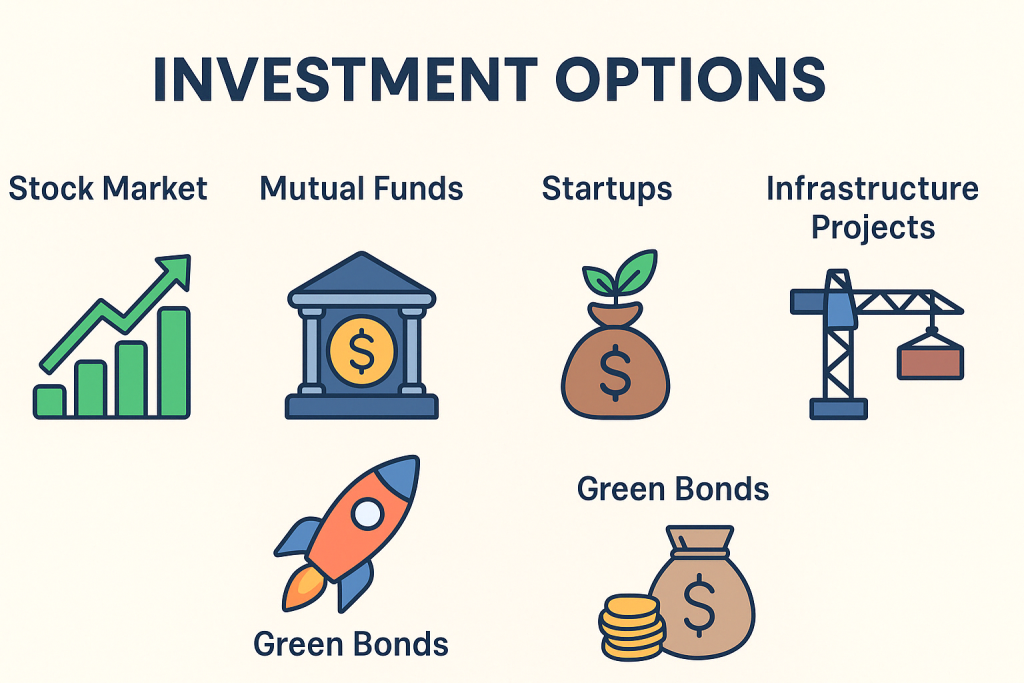
4. Green Bonds and Government Projects
Government and corporate green bonds may soon start to finance EV and hydrogen projects. These are long-term investments with low risk characteristics, ideally suited for conservative investors.
5. Infrastructure Funds
Investing into either the long-term debt of a company or the capital equity of a company that are building the backbone of these industries, such as: battery producers, lithium mining companies or companies who will set up hydrogen pipelines with refuelling stations.
Things to Watch For
- Market Volatility: These emerging categories of businesses may have considerable volatility over rapid changes in demand and pricing.
- Policy Changes: Incentives can change based on the elections. You should monitor government announcements about EVs and hydrogen projects, as incentives or rebates can change.
- Technology Disruption: Newer innovations may disrupt existing technologies. You need to remain aware of new technologies and be prepared for change.
- Long Gestation Period: It takes considerable time to develop the infrastructure and consumer adoption – when investing you need to have a long-term horizon.
Real World Examples and Case Studies
- Ola Electric and its Market Strategy: Ola Electric has pioneered the disruptive model in the two-wheeler market with a superior product that is stylish and affordable scooters.
- They are building a Future Factory for mass production of EVs.
- Tata Motors and their EV Aspirations: Tata has made a strong push in the EV market with the Tata Nexon becoming the best-selling electric car in India. Tata Motors plans to launch 10 more EVs before 2026, establishing their leadership position in the market.
- Adani’s Mega Green Hydrogen Vision: Adani Group has partnered with TotalEnergies to develop a mega green hydrogen hub in Gujarat. Adani is targeting global export markets.
Getting Started as a Novice
- Access brokerage platforms like Zerodha, Groww, or Upstox to purchase stocks or ETFs that target Electric Vehicles & Green Hydrogen.
- Stay updated on the industry with Moneycontrol, ET EnergyWorld, and BloombergQuint.
- Establish a SIP (Systematic Investment Plan) in an ESG fund to build holdings gradually.
- Take part in webinars or courses regarding investing in clean energy.
- Establish a clear goal for your investment is your target based on short-term momentum or long-term value in Electric Vehicles & Green Hydrogen?
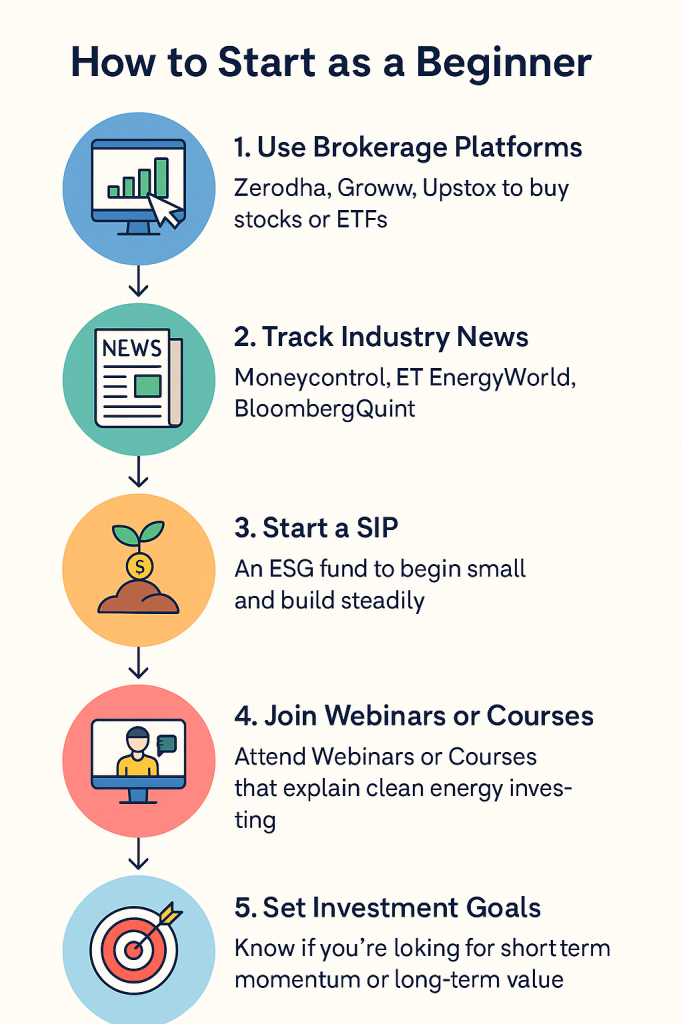
What Experts Are Saying
Those who come early will define the global economy” – Mukesh Ambani, Reliance Industries.
“India’s journey in EV is not just commercializing cars, it’s about creating the entire ecosystem. – Bhavish Aggarwal, CEO, Ola Electric.
Conclusion
To stay updated on real-time green hydrogen projects and investment schemes in India, you can refer to the official website of the Indian Renewable Energy Development Agency (IREDA).
Electric Vehicles & Green Hydrogen are the bridges we need for India to transition to clean energy. As infrastructure, technology, and investments grow, these sectors will redefine how we power our lives.
If you start investing in Electric Vehicles & Green Hydrogen now whether through company shares, mutual funds, or startups you position yourself for sustainable, long term growth.
But before you invest, conduct thorough research and align your strategy with your financial goals.
If you’re exploring global investment opportunities beyond electric vehicles and green hydrogen, don’t miss our guide on the Best Countries to Invest in 2025.

